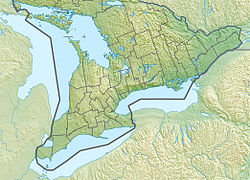| Welland River Chippawa Creek | |
|---|---|
 A boat on the river | |
| Location | |
| Country | Canada |
| Province | Ontario |
| Cities | |
| Physical characteristics | |
| Source | |
| • coordinates | 43°08′44″N79°56′18″W / 43.14542°N 79.93847°W |
| • elevation | approx. 248 m (814 ft) |
| Mouth | |
• location | Niagara River |
• coordinates | 43°03′48″N79°02′42″W / 43.06334°N 79.04504°W |
• elevation | 166 m (545 ft) [1] |
| Length | approx. 135–140 km (84–87 mi) [2] [3] |
| Width | |
| • minimum | 50 ft (15 m) [4] |
| • maximum | 100 ft (30 m) [4] |
| Discharge | |
| • location | Wellandport 43°00′18″N79°28′57″W / 43.00500°N 79.48250°W |
| • average | 8.72 m3/s (308 cu ft/s) [5] |
| • minimum | 8.57 m3/s (303 cu ft/s) [5] |
| • maximum | 8.88 m3/s (314 cu ft/s) [5] |
| Basin features | |
| Progression | Niagara River→ Lake Ontario→ Saint Lawrence River→ Gulf of Saint Lawrence |
The Welland River [6] (originally called the Chippawa Creek) is a river in the Golden Horseshoe that passes through the Southern Ontario cities of Welland and Niagara Falls. It flows from its source, a Drainage Basin just south of Hamilton, Ontario to meet the Niagara River.


